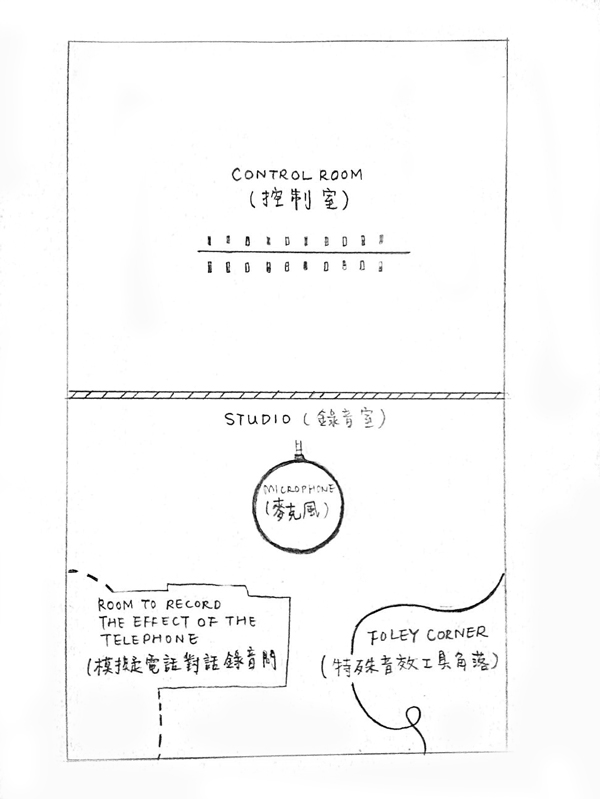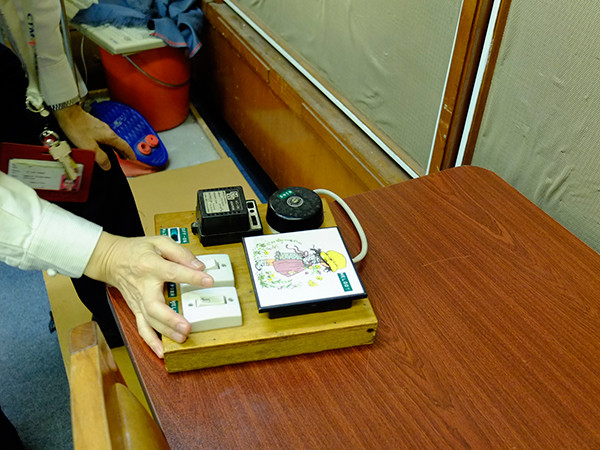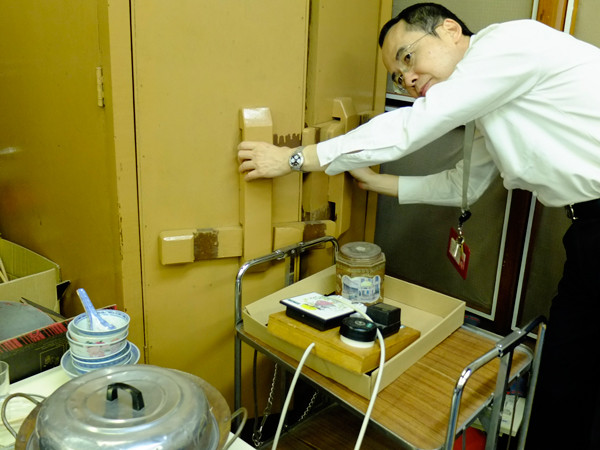Listen 來聽
A Sound Tour of the Radio Drama Studio 廣播劇錄音室聲音導賞行
Listen 來聽 / Meanderings - Feature Story 咫尺 - 專題故事 / Feature: Sound Professionals 聲音職人系列
Transcription 謄錄: Janie Chan Tsang/ 陳錚
English translation 英譯: Daniel Ho Sez-hin/ 何思衍10/19/2012
Hong Kong/ 香港
Bell Rings, Radio Drama, Script, Studio, sword, Telephone Conversation, The Ancient Chinese Doors, 刀劍, 劇本, 古裝門, 廣播劇, 錄音室, 門鈴, 電話對話

Mr. Ip Sai Hung, takes us on a tour of the studio where they record radio dramas
What we see over on this side is the control room, and over there is the recording studio. The actors basically sit together over there. Radio dramas generally have about ten actors, some of whom will help out with creating the sound effects. This is the recording microphone; our colleague responsible for this will switch this microphone for a “figure 8” bi-directional microphone. Generally speaking, we rarely use an omnidirectional microphone because the results will sound rather hollow. What’s the trickiest part about dual-channel microphones? The positioning — because we don’t usually just have two people in a dialogue or even just one in a monologue. Most of the time, there are three or four people conversing, and each time we hope the actor can get a bit closer to the mic or even speak directly to the mic, so everyone needs to make room for everyone else. Sometimes, this spatial adjustment doesn’t work. If one actor has to speak, followed immediately by another actor, how do we place the mic? So very often you will see the actor moving from this side over to the other side in order to have a dialogue. After the dialogue, the actor will move back — this is what’s called “ceding the mic” in radio dramas.
Additionally, there are also the so-called “distant sounds” and “close sounds”, since in radio dramas the “three-dimensional” sound we use is not truly three-dimensional. A truly three-dimensional sound is formed by a sound stage with two speakers — this is called a “wall of sound”, which is to say, with the three-dimensional sound effect on the radio you listen to, you can pick up the different positions from left to right. This is what are called “three-dimensional radio dramas”. These are rather complicated on the production level. You might need a 180-degree recording microphone, or else you leave one side empty and use a panel to determine the position. Even though ordinary radio dramas are still called “three-dimensional sound” but you won’t hear the left-to-right effect unless there are special adjustments. Generally speaking, there are only the near and distant effects — in other words, there is depth but not breadth. How to produce depth then? Aside from manipulating the fader, radio drama performances actually rely a lot on technique — walking closer and further, say, like when we say, “Oh, Ip is back.” “Oh, hi! How are you all doing?” You really are moving in this case. When you move, however, we don’t record the footsteps; we would create sound effects for that, since the two sounds (footsteps and the voice) can only be matched through external adjustments. How to match the voice with the footsteps? If you walk over by yourself, I would have to give you a board, while the sound of the board very much reflects the material of your shoes. So walking like that will usually produce footsteps that sound louder than the voice — after all, footsteps on the floor are loud (steps on the floor). This is why we always have carpeting. Here is a piece of rock and a piece of wood. You walk on a rocky surface on the streets, while you walk on wood at home. There are subtle differences. Live sound effects rarely use external faders because you wouldn’t know what the level is when you are adjusting. So the actor will say, “I’m back.” (footsteps). Did you notice it? This is the adjustment of the fader. The colleague in charge of sound effects will make adjustments to the sound and the voice in order to create an appropriate depth.
(The Library: So there are two people, right? One in charge of the sound effects, the other in charge of the voice) Right, exactly. (footsteps) This needs to be controlled. This is something that no one will tell you guys when you do an ordinary interview, because only those who are really in radio dramas will know the interrelated matches between the live sound, the voice, and the sound effects. Anything from the horse sounds in historical dramas, or fighting sounds — all these need to be matched and coordinated. Distant fighting sounds vs close fighting sounds all need the coordination of the actors and the sound effects crew. This is something rather special when we produce a radio drama. (The Library: before recording, do the special effects staff and the actors need to rehearse in advance?) That depends on how complicated it is. If we are talking about the footsteps just now —which everyone has done thousands of times — then we don’t need to rehearse. Some things we do, however, like special fighting sounds. Like this drama, for example, sometimes there are sound effects of arrows being shot, and these are not just random arrows; you could only do it once, so we would need to rehearse. We also have to coordinate the depth we want with the external fader control. Actors have to speak here, while our sound effect colleagues have to produce sounds over there, just to see if they can match or not — because we are recording at the same time, so we won’t be able to mix the sounds. Nowadays, recording is often done on multi-track recorders and then mixed. How good this is depends, because sometimes they can’t match properly and the volume is not enough, especially with opening and closing doors. And you also have to pay attention to the mood. Say if the mood is rather light, the door opening sound won’t be very loud, right? In other words, “Hi, I’m back.” — then you can just have a light door opening sound. We can actually enter this area, which is probably the most interesting part of radio dramas.
(The Library: Wow! It’s a box of treasures here.) Many instruments are damaged already, and besides, we bring so few here, so we haven’t brought these tools out for a long while. This is a door we normally use, but in fact you can’t open it. And I should tell you the fact that this door is so realistic was actually a mistake. When adding the sound, you use a box, while the four sides can be different doors. The upside of using a real door is that you can make real sounds, while the downsides are just too many. Say, for example, I’m in a good mood, and I come home whistling, then I open the door like this. But if I’m in an awful mood, then I will do this (brusquely unlocking and opening the door). So all these effects have to depend on the mood of the scene. The coordination between the live sound effects crew and the actors will really highlight the effect, which is what’s special about live sound effects. And there’s something else — the sounds of old doors.
(The Library: Oh, these are for historical dramas!) Why do they have to be made like this? Actually, they could have been made smaller. Why don’t they use another technique to create this effect — why does it have to be like this? In reality, ancient Chinese doors have something special about them: they must be lifted up a little and then pulled; this is something that is just not possible with a piece of wood. A single piece of wood can only produce a “pulling effect”, so with a real historical door, you really have to create an object in a similar shape. So the effect you see when the door is opened must be: one (the sound of the door being lifted), two (the sound of the door being pulled), and three (the sound of the door being pushed), while it is in exact reverse order when the door is being closed. So you can immediately hear if the person doing the sound effect is familiar with this or not; someone inexperienced won’t be able to produce this effect. Doors in the past were heavy; this is an imitation one, so it’s simpler. Now that we’re doing all this, what about a big gate? With those large gates, we would use more force — just a bit louder, see? (The sound of the door being slammed) We don’t do this, but this (gently opening the door). It has to sound like the door is being opened with difficulty. And this has to rely on one’s experience. As for the doorbell, we use real ones; I think this one is broken. (Presses a button; the bell rings) This one is alright; we just haven’t used it for too long. All these used to be done right here in the studio, and the most important thing was to press this right here in the studio (presses the doorbell). And then someone might say, “Coming!” and opens the door. This coordination of course depends of their experience and cooperation — otherwise you have the situation where someone opens the door before the doorbell has even rung, or the door being closed even before the person has entered. This frequently happens with inexperienced technicians. (The Library: is there someone specially responsible for the sound effects, or is this produced by the actors?)Most of the time, this is done by the actors on a part-time basis. Say in a play, there are ten actors, and at any given moment there are four or five actors acting, then the others will help out. Of course, there will be a colleague in charge of the sound and voice effects, while the others do this on a part-time basis. We just can’t assign too many people to be responsible just for this specialty, otherwise the expenses will be too high — and in any case most radio drama actors possess these kinds of skills. They come in being responsible for this, so they must know how to coordinate with others in order to produce the play — it will be terrible if they are too slow or too fast! So in reality, you have to be in this post to truly understand that the timing is like this.
Radio dramas fabricate sound with real sounds, though of course we sometimes have fake sounds. Like punching sounds are in fact made of two balls of thick paper tightly wrapped together; then when you hit them, you have to use enough force. You might ask, “Mr. Ip, why doesn’t it sound like punching?” Because of this microphone, plus there is echo; otherwise it would sound like the “pow” of punches. As for the sound of crossing swords, this [prop] has been worn down. And why’s that? Aside from the fact it’s been used for so long, they are actually two blades striking one another; you have to strike it vertically to create the effect. Listen! As I just mentioned, this is the distant sword sound (sound of two swords striking). But if you really have the main characters fighting it out, then you really need someone to strike at it hard. The sound of fighting you hear here is made with the sword striking hard at it. This concrete wall plaster has been completely worn down. These are all fabricated sounds, because they don’t reflect actual reality. In general terms, there is also the whipping sound. Experienced folks won’t use this; they would make the sound with their mouths. It’s really an art of the mouth. This is the sound of whipping — hear that? Or sometimes it could also be a strong gust of wind. So we use this. (The Library: do you use this to shoot arrows?) Yes, we use that. But often times with arrows, our colleagues use their mouths to create the effect, since this (whipping sound) has a wind effect, so it’s more often used as a whip. The sound of arrows shooting doesn’t have much wind, which is why they prefer their mouth — but I can’t, since I have never been a proper sound actor. I have always been — (laughs) — (The Library: the producer). Of all the overall sound effects of a radio drama, some are real and others are fabricated, and all these match our recording studio; yet others are recorded with “canned” music [check]. With the previous generation, even the sounds of thunder and rain will be made on site, but that is now quite rare. You need a big sheet of metal for thunder and a large sieve with beans inside for falling rain; all these objects take up a lot of space, yet canned music can produce these effects relatively well, so we don’t usually create these effects on site. Generally speaking, we use computers and mix with multi-track recording. Actually in the past, we would record and produce the sound and the voice together on site. After the recording, we would cut away the hemming and hawing and the rest is ready. We had to record everything on the spot at the recording station, open reel, along with the on-site music — that was quite a complicated production. After an afternoon of recording, we would all feel exhausted. The reason? Think about it: a play has many breaks, while each break has transitions and sound effects, along with the canned music of the control room, the Foley sound effects and background music of the recording studio — all these had to be recorded on site. If an actor just so much as hem and haw a bit, there’d be trouble. The on-site sound intake in the past was, as a model, a direct replica of live broadcasts; the only difference was that we would record it and cut out the hemming and the hawing. In an even earlier period, on-site recording was all done like that. Of course, it wouldn’t be so complex — truth be told, we would simplify the process. But in principle, all sounds will be produced and recorded within a certain timeframe. Now with multi-tracks, you normally don’t do this. The effects are carefully adjusted; the positions of the sound are more accurate. Actors’ hesitation isn’t that big of a deal because it can be cut out and re-adjusted. This is a difference of modern radio dramas from those of the past.
Also, there is a cloth in the room. The cloth (pulls it open to reveal something transparent) lets everyone see through it. This is to record the effect of the telephone. This microphone we use as a telephone. When making a phone call, I go in, as though it’s the other side of the telephone, making a phone call. The character or the other side listens to the telephone in there. So the voice sounds as though it came out from a phone. Why does it have to transparent? That’s to let everyone see one another, to allow for communication. The way we do this is a little different from the BBC (British Broadcasting Corporation). At the BBC, they have a room with headphones; neither side can see each other. However, we didn’t think that was so good — better to see one another and have some communication at least. And the effect? This doesn’t isolate the sound completely but could at least reduce other sounds. But as for those people standing over there, remember we can use figure-eight bi-directional and omnidirectional microphones — and unidirectional ones, which take in less sound. This curtain, as you can see, is rather high, and so won’t let sound through. As for other antiques — those are long gone. Like electronic sounds in the past: spaceship sounds had a button, and then the machine will make a sound. The machine was this big, and electric. (The Library: Like a synthesizer?). Not a synthesizer but an effecter. You press a button and out comes a frequency sound. (The Library: All electric sounds were produced by this machine?) That’s right. It apparently had a twenty-year history — when I joined a few years ago, back in 1982. Ten years ago, the recording studio was already like this. So, this is where we record radio dramas.
葉世雄先生帶你走一趟廣播劇錄音室
我們現在看到那邊是控制室,這邊是錄音室,演員基本上會集中坐在錄音室。廣播劇一般有大約十個演員,部分會幫忙製造音響效果。這是收音的麥克風,負責的同事會把這枝麥克風換成兩邊收音的八字型麥克風,一般而言我們是很少打全指向式的麥克風,這樣的聲音比較空洞。八字咪型麥克風最難控制的是什麼呢?是走位,因為不是經常只得兩個人對談或一個人獨白;很多時候可能有三四個人對話,每一次我們期望演員能稍為接近麥克風,甚至正對著麥克風,所以大家需要協調位置。但有時候調較位置並不可行,因為如果這位(演員)說話,然後那位(演員)接話,那麼如何擺放咪的位置?於是很多時候會見到演員由這個位置走到對面那個位置,就是與他對話。對話完畢後,一名演員會退開,這就是廣播劇的走位。
另外,有時會有所謂的遠聲和近聲,因為廣播劇我們一般用的立體聲其實都不是真正的立體聲,真正的立體聲真是兩個喇叭左右形成音響的舞台,叫「音牆」。即是由左到右,每一個位置,通過你聽收音機的立體聲效果會知道是在不同的位置,這叫做立體聲廣播劇。立體聲廣播劇在製作上是較複雜的,可能要用一枝180度收音的麥克風;或者是單軌錄音,用控制台定位。一般的廣播劇雖然叫立體聲,但你聽不到左跟右的效果,除非特別調較。一般來說,只有近和遠的效果。即是有深度,沒有闊度的。要如何造出深度呢﹖除了調較音量控制器外,其實廣播劇的演出上是很靠演技的,行近和行遠…即是我們說:「啊,葉世雄回來了。」「喂,好啊,你們好啊。」他真的是在走動。但走動時並不是收錄他的步聲,會有音響效果為他製造步聲。因為兩種聲音是要通過外面的調較才能做到步聲跟人聲相襯。人聲跟腳步聲如何相襯呢﹖可能那個人如果自己走過來,我要給他一塊地板,而地板的聲音與他鞋的質地關係甚大。所以這樣走動,很多時候步聲便會較人聲大。因為人踏在地板上是很重的。(踏地板聲)所以我們這裡一定全鋪上地毯。這裡有一塊石板和木板,如果在街上便在石板上走動,如果是在家裡便在木板上走動。這個是有竅妙的,現場音響,很少調較外面的音量控制器 ,因為經常調較會不知道音量是什麼,所以演員「回來了。」(腳步聲)發覺嗎﹖是這個控制音量大小。做特殊音效那位同事控制遠近大小聲,配合演員的聲音遠近,造成一個所謂的深度。
(聲音圖書館:即是說有兩個人,一個負責「咯、咯、咯、咯」,一個負責說話。)對啊!一個負責音效,另一個說話。(腳步聲)這個是要控制的,這個你們平日訪問是沒有人會告訴你們的,因為只有真正做廣播劇的人才會知道原來互相之間在現場,說話和做音效的配合情況。包括古裝的馬聲,或者打鬥聲,全部都要能夠互相配合,遠的打鬥聲或近的打鬥聲是完全要演員和做效果的同事配合。這就是我們在製作廣播劇時一個較特殊的錄音東西了。(聲音圖書館:在錄之前,做特殊音效的同事和演員要不要先排練﹖)要看看複不複雜。如果是剛才的步聲,已做過幾千次,大家便不用排練,但有些需要,例如特殊的打鬥聲,即是…例如這場戲,可能要有放箭的聲效,而這個放箭效果並不是胡亂放箭,只得一下,那我們便要排練一下。我們亦要與外面的音響控制師協調所需要的程度。演員要在這裡發聲,做音響的同事要在這裡做效果,看看可不可以結合,因為是同一時間錄在聲帶上,所以做不到混音的。如果是現在,會錄很多音軌,然後做混音。有好有不好,因為有時會配合不到,而且力度不同,最明顯是關門、開門聲。還要兼顧情緒。比如心情輕鬆的回來,開門不會弄出很多聲音的,是不是﹖即是「好啦,我回來了。」你便可以「嗖」一下開門聲。我們其實可以進入這個部份,亦是廣播劇最令人覺得有趣的地方。
(聲音圖書館:嘩!百寶箱。) 有很多工具都損壞了,而且我們很少用,很久都沒有拉這個工具了。這是我們一般用的門,但這個門其實開不到。我要告訴你,這個門如此真實其實是錯的。在配音上,其實是用一個箱子,四邊是不同的門。用真實的門,好處其實是做出真實的聲音,不好處是實在太大了。比如說我心情輕鬆的回來,吹著口哨,我便這樣開門;但如果我心情很惡劣,我就會(大力扭門鎖開門的聲音)這樣,所以這些效果是要按劇情配合。現場做效果的人和演員之間的配合會令到效果突出很多,這就是我們現場音效的特點。另外亦有一些舊式門的聲音。(聲音圖書館:啊!古裝劇用的。) 為什麼要這樣造呢﹖其實是可以造一個小的,為什麼不用其他方法做出這個效果,而一定要這樣呢﹖原來古裝門有一個特點,一定托起,然後才拉,一條木是做不到的。一條木最多只做到的拉的效果,要做古裝門,真真正正要這個形狀的東西才能做到。你看開門的效果一定是一(托門聲)二(拉門聲)三(推門聲)這樣。關的時候是三(推門聲)一(托門聲) 二(拉門聲)。所以你一聽便會知道做效果的人是否熟手,如果是新人就做不到這種效果。以前的門是很重的,這個是模仿的,比較簡單。但我們做起來,大閘呢?大閘嘛,我們會加重,大聲少許,見到嗎﹖(門大力碰撞的聲音)我們不是這樣開門的,(輕力開門的聲音)會這樣開。像是很艱難才開到門一樣,這便要靠同事的經驗了。而門鐘都會用真實的,這個好像壞了。(按掣聲、響鐘聲)這個沒有事,太久沒有用。這些在以前都是現場做的,最重要是現場按這個(按掣響鐘聲),有人應門「來了」,然後有人開門。他們的配合要視乎經驗及彼此的搭配,否則分分鐘未按門鈴已經開了門,或者人未進門便已關門,經常都有不熟手的人會出現這種程況。(聲音圖書館:是有人專門負責音效的部份,還是由演員來做﹖)多數都是演員兼任,即一場戲有十個演員,那一刻四、五人演戲,其他人便幫忙。當然會有一位同事是指定負責音響、聲音,其餘的演員都要兼任。因為我們不能派太多人只負責這範疇,成本會很重,而大部分的廣播劇演員都具備這方面的知識,在他們入職時都要負責這個崗位,他們一定要明白如何跟其他人配搭效果才可以演戲,如果每次都慢了或是快了便糟糕!所以要實際擔任這個崗位才知道原來時間是這樣的。
廣播劇是聲音的模擬,是真實的聲音,當然我們也會有假的音效。例如拳擊聲的音效,其實是兩團很重的紙,紮得很實;然後打的時候,力度要夠(打擊聲音)。你可能會問:「葉Sir,為什麼不太相似﹖」因為是這個麥克風,加上有回音,便會發出「發、發聲」。至於刀劍聲(刀劍摩擦聲音),這個其實都磨損了。為什麼呢﹖除了用得久了,真正打磨時是兩把刀,但一定要垂直地敲下去,就會造成這個效果。你聽,我剛才說了有些遠聲(兩把刀互敲的聲音),這樣便是遠收了。但如果真是到主角出現要拼勁就是剛才那一下了,要很有力度的同事才能打到。你見決鬥時的「轟、轟」聲就是剛才刀刀敲下去。這個水泥的批盪都磨損了。這些就是模擬的聲音了,因為不是真實的反映。一般來說,還有鞭聲。老經驗的同事是不會用這個,會用口做出效果,是口技來的。這是鞭風,聽不聽到﹖或者有時候是一些很強勁的疾風,我們都是用這個。(聲音圖書館:射箭是否用這個﹖)都是用這個。但射箭很多時候同事都是用口技的,因為這個(揮鞭聲)有風聲,較多用在鞭上;但射箭的風聲不會很大,於是他們喜歡口技,但我做不到,因為我未當過正式的演員。我一來便已經做(笑) 。(聲音圖書館:監制。) 廣播劇的音響大致上現場有些是真實的,有些是虛擬的,亦配合我們的唱片房,有些是用錄製好的罐頭音效去做。以前的一代,行雷聲、落雨聲都會在現場製造,而現在便很少了,因為行雷用鐵片,而落雨用大篩箕,放些豆在裡面。這類物件體積較大,而罐頭音樂相對地可以做出這個效果,所以就不再用這個現場做的特殊音效。一般來說,我們現在會用電腦,用多音軌做混聲。其實過往我們會在現場將聲音、音樂一同錄製。即是錄製之後,只須剪去NG部分,其餘都做好了。我們只要在出面的唱盤機、開盤式錄音機,連同過場音樂同時錄製。那是一個頗繁複的製作,完成一個下午的錄音,我們會十分疲憊。因為,你想想,一齣戲有很多不同場口,每個場口有過場、音效;控制室的罐頭音樂、錄音室的特殊音效、背景音樂…全部都要在現場錄製,如果演員NG便麻煩了。我們過往的現場收音,整個模式是一個現場直播的翻版,只是改用錄音這方面有所不同,而且我們會剪掉NG的部分。在更早的年代,現場直播都是這樣做的,當然不會做到如此複雜。坦白說,是會簡化一點,但基本上,所有聲音都會在一段時間內進行。現在有多音軌後就一般都不會用這個方法,效果要慢慢調節,聲音的位置會較準確。演員NG並不太重要,因為已經剪掉,重新調較了。這就是現在的廣播劇與以往廣播劇的不同之處。
另外,這個房間內有一塊布。布上有機個膠孔(是透明的),可以互相看見的。這是錄電話音效的,這枝麥克風,我們當作是電話。打電話時我在入面,像是在電話的另一端,我在這裡打電話,主角、對方聽電話便在裡面。那麼人聲便變得好像在電話發出的聲音。為什麼要透明呢﹖是為了要互相看見,要有交流。我們這個做法與BBC(英國廣播公司) 稍為不相同。BBC是有一個房間,靠戴耳機,互相看不見對方的樣子,但我們覺得這樣不太理想,最好可以互相看到,有一些交流。而效果就…這個不是完全隔聲,但已經可以將雜聲減輕了。但那邊的人,你要記住我們可以八字型及全指向式的麥克風,還有單向…單向其實收的聲音是比較少。但那個幕,你可以見到,是比較高的,不會漏聲。其餘古董便沒有了,例如以前電子的聲音,太空船的聲音都是按,然後機器便會發出聲音,那部機器是這麼大部,是用電的。(聲音圖書館:即是合成器那樣?)不是合成器來的,是音效機,效果器。你按這個按鈕,便有電波聲。(聲音圖書館:全部電子聲音就由那部機器產生﹖)是的,那部機器聽說有二十年歷史,即是我十幾年前入職時,我八二年入職嘛,十年前已經全部都是這個錄音室。好!廣播劇錄音的地方便是這裡了。

Foley Coner
特殊音效工具角落

Bell Rings
門鈴

Sword
刀劍

The Ancient Chinese Doors
古裝門

Room to Record the Effect of the Telephone Conversation
模擬電話對話錄音間

Radio Drama Script
廣播劇劇本

Radio Play Manuscript
廣播劇劇本手稿